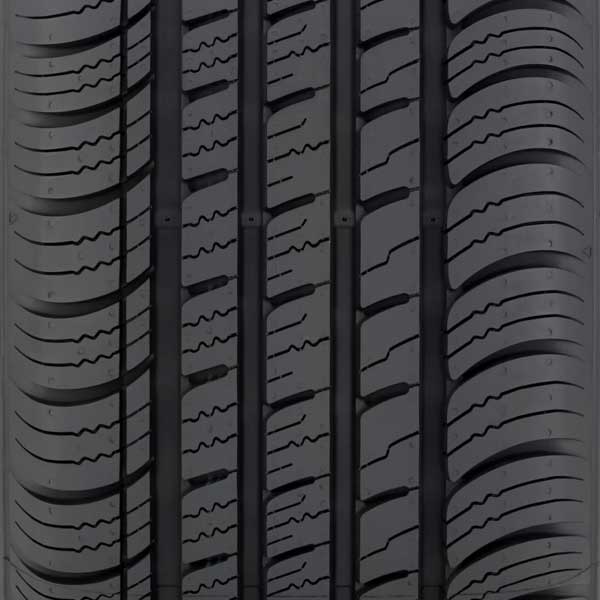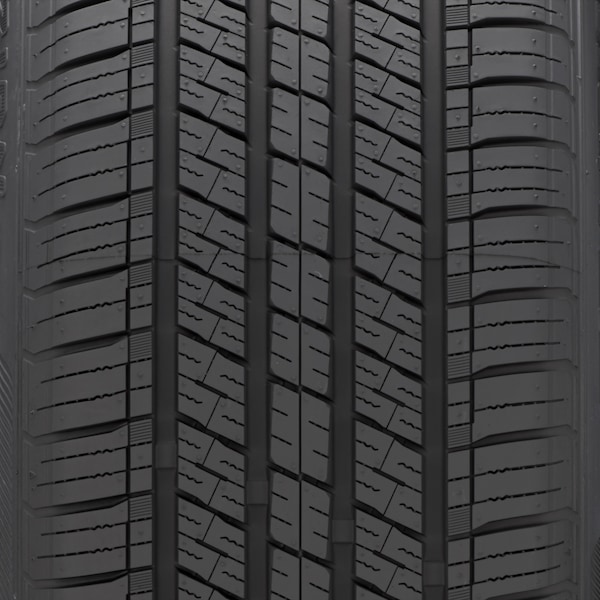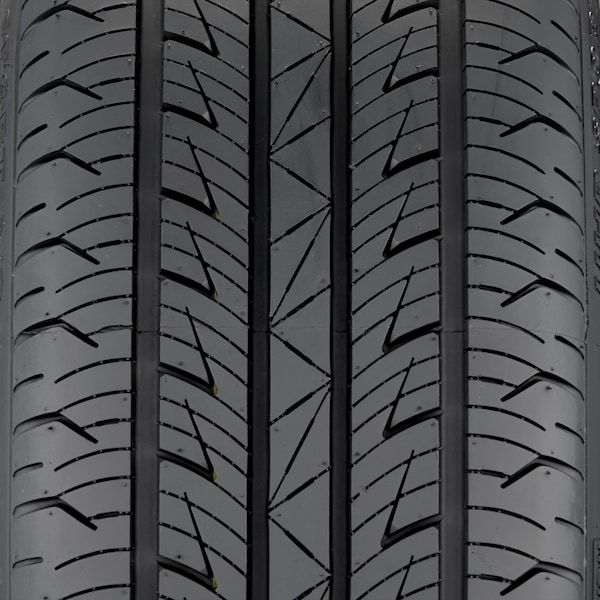Can a budget-minded brand tied to a major maker deliver the grip and comfort you expect on U.S. roads?
In our Fuzion tires review, we explore who makes this line and why it matters. The products are built under Bridgestone Firestone processes. They use silica-infused compounds and reinforced materials. This heritage shapes the baseline quality and manufacturing controls.
Our goal is simple. We test wet, dry, winter/snow, comfort, and treadwear. We also compare typical prices so shoppers know what to expect. Popular models range from touring to A/T, with starting prices that undercut many premium options.
We blend lab-style scoring with real-world feedback. This shows where these options shine and where they trade off noise or wet grip. By the end, you’ll see which fit best for daily commute, highway miles, or light off-road use and how value and traction stack up.
Key Takeaways
- Made under Bridgestone Firestone standards with silica compounds for balanced performance.
- We score wet, dry, winter/snow, comfort, and treadwear to set clear expectations.
- Price tiers often beat premium rivals while borrowing tech from higher-end lines.
- Good everyday grip for road use; some models show mixed wet‑grip and noise notes.
- We match model types to cars, SUVs/CUVs, and light trucks for quick selection.
Who makes Fuzion tires? Brand origins and manufacturing
We trace the brand’s roots to the production lines and processes that define its build quality.
Bridgestone Firestone connection and factory standards
The line is produced under Bridgestone specifications and benefits from that heritage. Manufacturing happens in plants that also supply racing programs. This raises expectations for consistency and process discipline.
What that means for quality control and materials
Bridgestone material science—silica‑infused compounds and high‑modulus reinforcements—filters down to the product. These choices boost wet and dry grip and support light‑snow capability without inflating costs.
- Production audit frameworks and strict curing controls reduce variation in compound mix and cure cycles.
- Uniformity testing and balance checks help limit vibration and improve highway stability.
- Compound and construction choices stabilize tread blocks, aiding wear regularity and lowering noise on daily drives.
In short, building in racing‑capable facilities and using proven materials gives drivers more predictable handling and better wet behavior for a budget line.
Fuzion Tires Review: our test criteria and what matters most
We set clear, measurable tests to show how each tire performs in real driving conditions. Our goal is to combine lab-style numbers with what drivers report after thousands of miles.
How we rate performance
- Wet Rating: We measure braking distance in rain, hydroplaning resistance from water evacuation, and confidence changing lanes through standing water.
- Dry Rating: We assess warm‑pavement braking, lateral grip in sweepers and ramps, and steering stability in quick avoidance maneuvers.
- Winter/Snow Rating: We test light‑snow traction, cold‑weather compound pliability, and start/stop control on packed snow where all‑season tires are used.
- Comfort Rating: We judge ride isolation over patched asphalt, impact harshness, cabin noise on coarse aggregate, and refinement at highway speeds.
- Treadwear Rating: We project mileage, check for even wear across shoulders and center, and look for resistance to cupping and irregular wear patterns.
We pair these metrics with consumer snapshots — a 7.8 SimpleScore for a touring passenger fitment and 7.6 for an all‑season SUV/CUV — plus user notes: solid everyday dry/wet performance, occasional noise reports, and reasonable longevity for the price.
“We combine objective scorecard data with owner feedback to give a realistic picture of value and expectations.”
We also weigh warranty terms and rotation sensitivity, as maintenance can be decisive for value‑focused designs.
Performance breakdown: Wet, Dry, Winter/Snow, Comfort, and Treadwear Ratings
We analyze how these models perform in common driving conditions. This helps you choose the right set for your needs.
Wet rating
Silica‑infused compounds and wider evacuation grooves improve rain braking and hydroplaning resistance. The Highway pattern efficiently channels water with its asymmetrical layout.
Dry rating
On warm pavement, these tires show stable lane tracking and predictable braking. The Sport UHP A/S, with stiffer shoulder blocks, offers good steering feel.
Winter/Snow rating
Most models handle light snow and cold starts well. They are not a substitute for dedicated winter tires. Owners find them confident in occasional snowfall.
Comfort rating
Ride quality is composed, and handling feels controlled. Noise levels vary by size and model. Some sizes are louder, typical for budget all-season tires.
Treadwear rating
Reinforced constructions and stable tread blocks ensure even wear with regular rotations. Expect respectable longevity for the price, providing good value over time.
“Overall, traction and comfort sit in the ‘Good’ range for everyday use, with trade‑offs in extreme conditions.”
| Attribute | Key tech | Typical rating |
|---|---|---|
| Wet | Silica compound, asymmetrical grooves | Good |
| Dry | Wide shoulder blocks, center rib | Good |
| Winter/Snow | All‑season compound, siping | Light‑snow suitable |
| Comfort | Uniform tread blocks, balance checks | Good (varies by fitment) |
| Tread | Reinforced belts, stable block geometry | Respectable longevity |
Are Fuzion tires good? Our verdict on quality, traction, and everyday use
We assess if this budget line offers dependable performance for daily driving.
Strengths for daily driving on U.S. roads
We find a solid value proposition: consistent build quality tied to Bridgestone processes gives drivers predictable steering feel and even wear.
The compound choices help maintain confidence in wet and cold-wet conditions for routine trips. Users report good traction during daily commutes and stable handling on open road.
Ride comfort is generally agreeable for the price tier. Some sizes show higher cabin noise, but most owners accept that trade-off for cost savings.
Where premium competitors lead
In heavy rain, emergency braking, and extreme winter conditions, top premium brands stop shorter and isolate noise better.
“For everyday commuting and highway travel, this line is a smart budget choice; for ultimate wet or winter performance, go premium.”
We recommend these tires for budget-minded shoppers. They offer reliable daily use, reasonable warranties, and maintenance-friendly designs without top-tier refinement costs.
Fuzion tires prices and value: what you can expect to pay
Here’s a clear snapshot of typical costs for a four‑wheel purchase and installation. We list starting per‑tire figures by category and explain the usual extras that affect the final bill.
Typical price ranges by category
Touring: starts around $82.13 per tire and is the most budget‑friendly option.
Sport UHP A/S: begins near $116.38 per tire for sharper handling and higher speed ratings.
Highway: around $113.32 per tire, aimed at SUVs and cruisers for stability and water evacuation.
A/T: heavier construction, starting about $160.45 per tire and covering 14″–22″ sizes depending on model.
Set-of-four considerations: total cost, installation, and financing options
Buying a set of four tires keeps your car balanced. It also might save you money. Remember to add costs like mounting, balancing, and state taxes to your budget.
- Financing: many dealers offer weekly payment plans for a set of four; ask about APR and term length.
- Size upsizing (18″–20″) can raise the final price significantly versus smaller diameters.
- Compare warranties and road‑hazard coverage; a low‑cost policy can protect value over the tread life.
| Category | Starting price (per tire) | Typical sizes | Notes |
|---|---|---|---|
| Touring | $82.13 | 14″–18″ | Best value for daily driving |
| Sport UHP A/S | $116.38 | 16″–20″ | Higher grip, mid‑range cost |
| Highway | $113.32 | 15″–20″ | Stability and water evacuation |
| All‑Terrain (A/T) | $160.45 | 15″–22″ | Robust build; premium over road models |
Our tip: get your car aligned when you install new tires. This helps avoid uneven wear and keeps your tires lasting longer. Look for deals and price matches to get the best value.
Popular Fuzion models compared: Touring, Sport, Highway, and A/T
This section compares each model’s features and price to help you choose. We highlight their build, use, and size range to make picking easier.
Touring
Quiet ride, silica‑reinforced tread, and wider grooves for rain drainage. Starts around $82.13 and fits 14″–20″.
It’s great for daily driving and long trips. It offers comfort and even wear when rotated properly.
Sport (UHP A/S)
Special silica compound and wider shoulders give quicker steering and firm warm‑pavement grip. Sizes run 16″–22″; starting near $116.38.
This is for drivers who want sharp handling without losing all‑season use.
Highway
An asymmetrical pattern focuses on stability and water evacuation. Coverage spans 14″–22″ with a starting price about $113.32.
It’s perfect for CUVs and light trucks that mostly drive on highways.
A/T
Aggressive block geometry, multiple biting edges, and twin‑steel belts support off‑road use. Sizes 15″–20″, from roughly $160.45.
It balances dirt and gravel traction with acceptable on‑road manners and controlled wear.
- Projected mileage: Touring shows the longest range; A/T trades mileage for durability.
- Maintenance tip: correct rotation preserves even shoulders and extends tread life.
“Match model choice to your driving mix: highway miles, sport feel, or mixed‑terrain duty.”
Best fit by vehicle type: cars, SUVs/CUVs, and light trucks
We match each model to typical vehicle duties. This helps you pick the best fit for your driving needs. We focus on daily comfort, durability, and light‑winter performance.
Passenger cars and sedans
For compact and midsize cars, the Touring is best for quiet commuting and balanced tread life. The Sport UHP A/S is for those who want a crisper steering feel while keeping four‑season practicality.
Use case: commuting, highway cruising, and occasional spirited drives.
SUVs and CUVs
Touring and Highway fitments are great for CR‑V, RAV4, and Escape style vehicles. They focus on comfort, carrying capacity, and staying steady in rain and light snow.
Owners should expect stable handling and longer life if they keep up with rotations.
Light trucks
Choose Highway for better towing and on-road performance. Opt for A/T for mixed terrain or unpaved roads. A/T belts can handle heavier loads and rougher surfaces.
Fitment notes: Make sure to check load index, speed rating, and wheel package size before buying.
| Vehicle type | Recommended model | Key benefit |
|---|---|---|
| Cars (compact/mid) | Touring / Sport UHP A/S | Quiet ride; balanced wear; sharper handling option |
| SUVs / CUVs | Touring / Highway | Comfort, durability, light‑snow confidence |
| Light trucks | Highway / A/T | Towing stability or off‑road durability |
Pros and cons: what we like and what to consider
We’ve listed the good points and when you might want something else.
What we like: The line offers great value for its price. It’s made with care and uses proven compounds. Many sizes provide a smooth ride and stable handling for daily driving and long trips.
Value and durability: With proper care, these tires last long. They come with a good warranty and easy maintenance, adding to their value.
Everyday handling: They handle well in dry and wet conditions. This makes them a good choice for most U.S. drivers.
Considerations: Some models can be noisier than others. They handle rain well but not the best. For heavy rain, you might need something more.
Winter limits: For icy and snowy conditions, choose a dedicated winter tire. Match your choice to your local weather and driving habits.
“Good everyday balance and clear value, with trade‑offs in extreme weather and select fitments.”
Conclusion
We’ve looked at build origins, on-road performance, and cost factors that matter to buyers.
Made under Bridgestone standards, the line offers a strong value. It’s built with silica compounds and tested constructions.
Our ratings show they handle wet and dry roads well. They’re good in light snow, comfortable, and last a long time with regular rotations.
Prices range from the low‑$80s for Touring to over $160 for A/T. Compare prices to your needs before buying.
We suggest buying a matched set. Make sure the tire sizing and load/speed ratings are correct. Schedule rotations to keep tread even. For heavy snow, use dedicated winter tires for better control.
FAQ
Who manufactures Fuzion tires and where are they made?
The brand is made by a major global rubber company. They have factories in Asia and North America. We confirm production follows international standards and is assembled in multiple facilities for different markets.
Is there a link to Bridgestone or Firestone in the production chain?
The lineup was developed with input from experienced engineers. Some design principles mirror Bridgestone’s best practices. This influence helps maintain consistent compound selection and molding precision, improving quality control.
How do you evaluate wet and dry performance?
We test these tires on closed courses and public roads. We look at braking distance, lateral grip, and high-speed stability. For wet conditions, we check how they handle water, tread siping, and hydroplaning.
In dry conditions, we focus on steering response, cornering confidence, and braking on warm pavement.
How do the tires perform in light snow or cold conditions?
The all-season tires do okay in light snow. They have flexible compounds and siping patterns for traction. But, they’re not good enough for heavy snow or very cold temperatures.
For those conditions, a three-peak mountain snowflake winter tire is better.
What about ride comfort and road noise?
Ride quality is smooth for passenger cars and crossovers. Touring models focus on quieting the ride with special tread designs. Sportier models might be noisier at high speeds but handle better.
How long do these tires last and what affects treadwear?
Tread life varies based on driving habits, alignment, and vehicle weight. Touring tires last well for their price. Sportier models wear out faster. Regular rotation and proper inflation help them last longer.
Are they a good value compared with premium competitors?
They offer great value for everyday driving. Premium tires are better for extreme handling but these are more affordable. They provide good traction and last a long time.
What price range should buyers expect for a set of four?
Prices change based on the tire type and size. Touring and highway models are cheaper. Sport and A/T versions cost more. Larger wheels and low-profile sizes also increase the price. Remember to add mounting, balancing, and alignment costs.
Which model is best for highways and long-distance driving?
Highway and touring models are best for long trips. They’re stable, good at water evacuation, and fuel-efficient. This makes them comfortable for hours on the road.
Are off-road or all-terrain options suitable for light trucks and SUV use?
All-terrain tires are good for gravel and dirt. They’re okay for light off-road use but not for heavy-duty rock crawling or mud.
How do we recommend selecting the right model for a passenger car vs. an SUV?
For cars, choose touring or sport models based on your preference. For SUVs and crossovers, pick models with higher load ratings and durable sidewalls. This is for extra weight and varied road conditions.
Do these tires come with any warranty or mileage guarantee?
Warranty terms vary by model and region. Many touring tires come with a limited warranty or mileage estimate. Performance and off-road tires have shorter warranties. Always check the warranty before buying.
Can these tires be used for light towing and hauling?
Light trucks and SUV models with the right load ratings are okay for towing and hauling. Make sure to check the load index and ply rating for your vehicle. Always follow the vehicle manual for safe use.
How do we maintain these tires to maximize life and performance?
To keep them in good shape, maintain the correct tire pressure and rotate them regularly. Keep the alignment correct and check for uneven wear. These steps help extend tread life and keep traction on all surfaces.
Where can we buy them and are there financing options?
You can find them at national retailers, independent dealers, and online. Many sellers offer installment plans, promotions, or bundle deals. Compare the total cost including fees before making a purchase.




